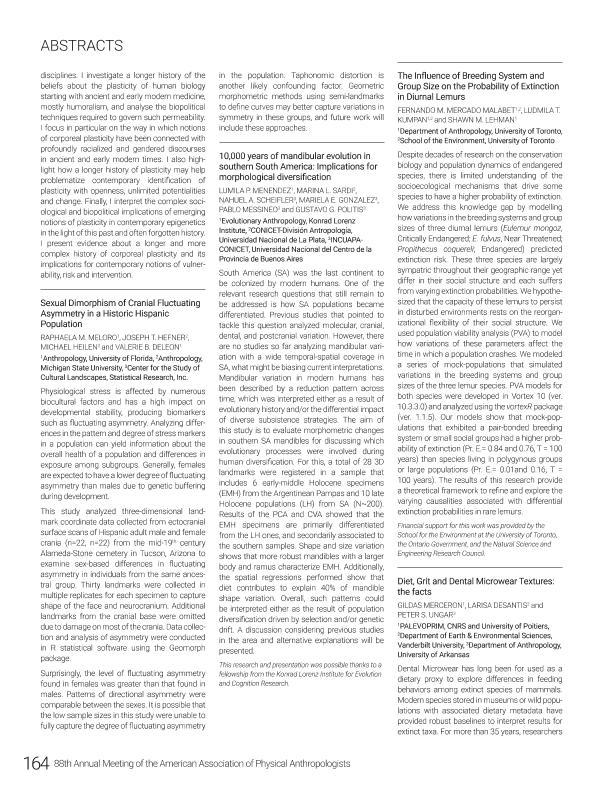Mostrar el registro sencillo del ítem
dc.contributor.author
Menendez, Lumila Paula

dc.contributor.author
Sardi, Marina Laura

dc.contributor.author
Scheifler, Nahuel Alberto

dc.contributor.author
Gonzalez, Mariela Edith

dc.contributor.author
Messineo, Pablo Geronimo

dc.contributor.author
Politis, Gustavo Gabriel

dc.date.available
2021-09-09T16:12:12Z
dc.date.issued
2019
dc.identifier.citation
10,000 years of mandibular evolution in southern South America: Implications for morphological diversification; 88th Annual Meeting of the American Association of Physical Anthropologists; Cleveland; Estados Unidos; 2019; 164-164
dc.identifier.issn
0002-9483
dc.identifier.uri
http://hdl.handle.net/11336/140015
dc.description.abstract
South America (SA) was the last continent to be colonized by modern humans. One of the relevant research questions that still remain to be addressed is how SA populations became differentiated. Previous studies that pointed to tackle this question analyzed molecular, cranial, dental, and postcranial variation. However, there are no studies so far analyzing mandibular variation with a wide temporal-spatial coverage in SA, what might be biasing current interpretations. Mandibular variation in modern humans has been described by a reduction pattern across time, which was interpreted either as a result of evolutionary history and/or the differential impact of diverse subsistence strategies. The aim of this study is to evaluate morphometric changes in southern SA mandibles for discussing which evolutionary processes were involved during human diversification. For this, a total of 28 3D landmarks were registered in a sample that includes 6 early-middle Holocene specimens (EMH) from the Argentinean Pampas and 10 late Holocene populations (LH) from SA (N~200). Results of the PCA and CVA showed that the EMH specimens are primarily differentiated from the LH ones, and secondarily associated to the southern samples. Shape and size variation shows that more robust mandibles with a largerbody and ramus characterize EMH. Additionally, the spatial regressions performed show that diet contributes to explain 40% of mandible shape variation. Overall, such patterns could be interpreted either as the result of population diversification driven by selection and/or genetic drift. A discussion considering previous studies in the area and alternative explanations will be presented.
dc.format
application/pdf
dc.language.iso
eng
dc.publisher
American Association of Physical Anthropologists
dc.rights
info:eu-repo/semantics/openAccess
dc.rights.uri
https://creativecommons.org/licenses/by-nc-sa/2.5/ar/
dc.subject
Morphology
dc.subject
Americas
dc.subject
Geometric morphometrics
dc.subject.classification
Otras Historia y Arqueología

dc.subject.classification
Historia y Arqueología

dc.subject.classification
HUMANIDADES

dc.title
10,000 years of mandibular evolution in southern South America: Implications for morphological diversification
dc.type
info:eu-repo/semantics/publishedVersion
dc.type
info:eu-repo/semantics/conferenceObject
dc.type
info:ar-repo/semantics/documento de conferencia
dc.date.updated
2021-08-31T14:25:42Z
dc.journal.volume
168
dc.journal.number
S68
dc.journal.pagination
164-164
dc.journal.pais
Estados Unidos

dc.journal.ciudad
Hoboken
dc.description.fil
Fil: Menendez, Lumila Paula. Konrad Lorenz Institute; Austria. Consejo Nacional de Investigaciones Científicas y Técnicas; Argentina
dc.description.fil
Fil: Sardi, Marina Laura. Consejo Nacional de Investigaciones Científicas y Técnicas; Argentina. Universidad Nacional de La Plata. Facultad de Ciencias Naturales y Museo. Departamento Científico de Antropología; Argentina
dc.description.fil
Fil: Scheifler, Nahuel Alberto. Consejo Nacional de Investigaciones Científicas y Técnicas. Centro Científico Tecnológico Conicet - Tandil. Investigaciones Arqueológicas y Paleontológicas del Cuaternario Pampeano. Universidad Nacional del Centro de la Provincia de Buenos Aires. Investigaciones Arqueológicas y Paleontológicas del Cuaternario Pampeano; Argentina
dc.description.fil
Fil: Gonzalez, Mariela Edith. Consejo Nacional de Investigaciones Científicas y Técnicas. Centro Científico Tecnológico Conicet - Tandil. Investigaciones Arqueológicas y Paleontológicas del Cuaternario Pampeano. Universidad Nacional del Centro de la Provincia de Buenos Aires. Investigaciones Arqueológicas y Paleontológicas del Cuaternario Pampeano; Argentina
dc.description.fil
Fil: Messineo, Pablo Geronimo. Consejo Nacional de Investigaciones Científicas y Técnicas. Centro Científico Tecnológico Conicet - Tandil. Investigaciones Arqueológicas y Paleontológicas del Cuaternario Pampeano. Universidad Nacional del Centro de la Provincia de Buenos Aires. Investigaciones Arqueológicas y Paleontológicas del Cuaternario Pampeano; Argentina
dc.description.fil
Fil: Politis, Gustavo Gabriel. Consejo Nacional de Investigaciones Científicas y Técnicas. Centro Científico Tecnológico Conicet - Tandil. Investigaciones Arqueológicas y Paleontológicas del Cuaternario Pampeano. Universidad Nacional del Centro de la Provincia de Buenos Aires. Investigaciones Arqueológicas y Paleontológicas del Cuaternario Pampeano; Argentina
dc.relation.alternativeid
info:eu-repo/semantics/altIdentifier/url/https://onlinelibrary.wiley.com/doi/10.1002/ajpa.23802
dc.relation.alternativeid
info:eu-repo/semantics/altIdentifier/doi/https://doi.org/10.1002/ajpa.23802
dc.conicet.rol
Autor

dc.conicet.rol
Autor

dc.conicet.rol
Autor

dc.conicet.rol
Autor

dc.conicet.rol
Autor

dc.conicet.rol
Autor

dc.coverage
Internacional
dc.type.subtype
Reunión
dc.description.nombreEvento
88th Annual Meeting of the American Association of Physical Anthropologists
dc.date.evento
2019-03-27
dc.description.ciudadEvento
Cleveland
dc.description.paisEvento
Estados Unidos

dc.type.publicacion
Journal
dc.description.institucionOrganizadora
American Association of Physical Anthropologists
dc.source.revista
American Journal Of Physical Anthropology

dc.date.eventoHasta
2019-03-30
dc.type
Reunión
Archivos asociados
